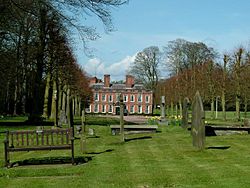Whitmore Hall facts for kids
Quick facts for kids Whitmore Hall |
|
|---|---|
 |
|
| General information | |
| Architectural style | Carolean |
| Location | Whitmore, Staffordshire |
| Country | England |
| Coordinates | 52°58′06″N 02°16′58″W / 52.96833°N 2.28278°W |
| Owner | Private ownership, Cavenagh-Mainwaring family, formerly leased to Thomas Twyford |
Whitmore Hall is a beautiful old house in Whitmore, Staffordshire, England. It has been the home of the Cavenagh-Mainwaring family for a very long time. This special house is a "Grade I listed building," which means it's super important for its history and amazing design. It's a great example of a Carolean style manor house, built during the time of King Charles II.
Contents
The Story of Whitmore Hall
Early Days and Owners
The land where Whitmore Hall stands has a very long history. Around the time of the Norman Conquest in 1066, a person named Richard the Forester owned the area. Whitmore was even mentioned in the Domesday Book, a famous survey from 1086.
Later, in 1204, a man named William Boterel became the owner. He was known as the "Lord of Whitmore near Newcastle-under-Lyme." The estate then passed to the Mainwaring family in 1519. They got it through the family of Alice Boghay, who was a descendant of the Boterel family.
The Mainwaring family has owned Whitmore Hall ever since. Many members of the Mainwaring family served as the High Sheriff of Staffordshire. This was an important role, like a chief law enforcement officer for the county.
Who Lives There Now?
For about 60 years, starting in 1863, the house was rented out to other people. One of the people who lived there was Thomas Twyford, who made pottery. He stayed at the hall for 30 years.
However, the Cavenagh-Mainwaring family returned to live in the hall in the 1920s. Today, Whitmore Hall is still a private home for the family. You can visit it on certain days between May and August to see this historic place for yourself.
How Whitmore Hall Looks
Building Design and Features
The original house was updated and covered in red brick around 1676, during the reign of King Charles II. It has a grand front with a decorative railing called a balustrade. The front of the house has nine sections, called bays, and two floors.
There is also a stable building that is very old and well-preserved. It was built in the Elizabethan style, which was popular much earlier than the main house.
More to Explore
- List of Grade I listed buildings in Staffordshire
- Listed buildings in Whitmore, Staffordshire

